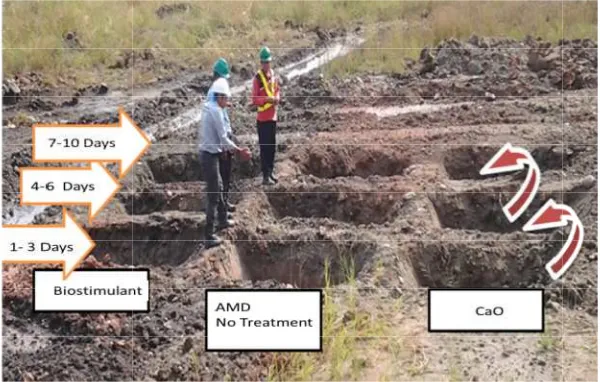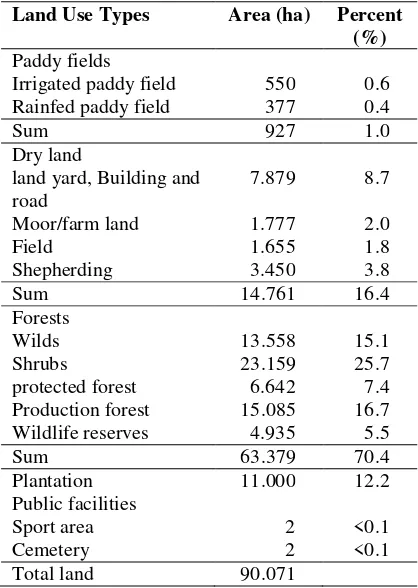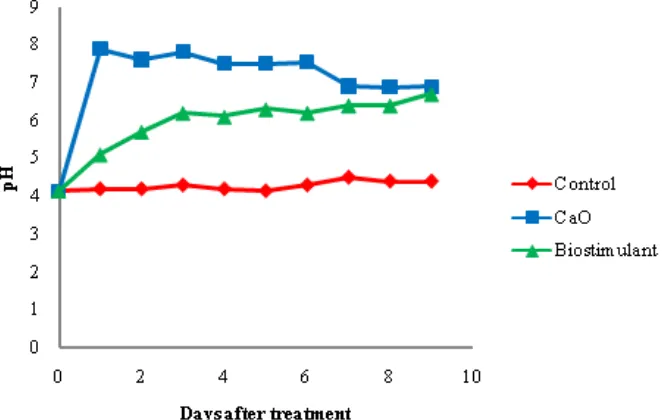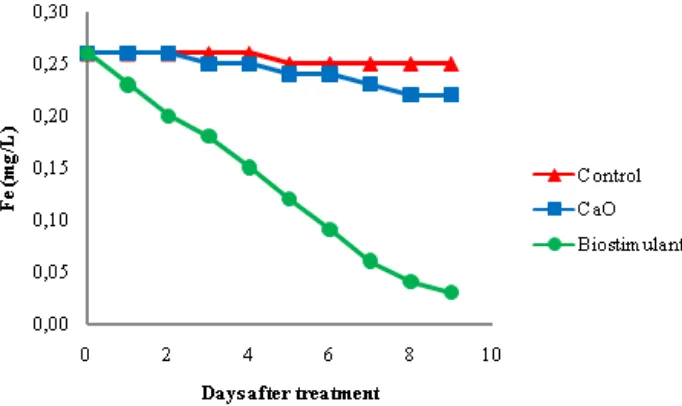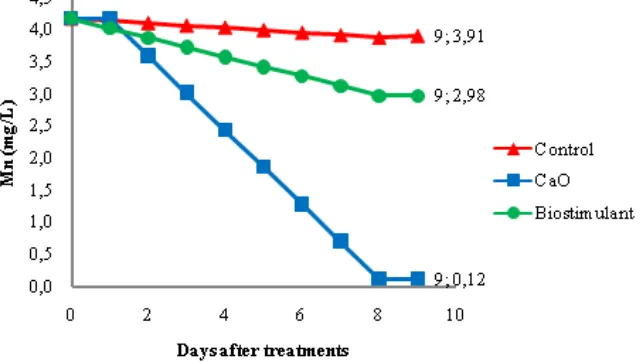ISSN: 2339-076X (p); 2502-2458 (e),
Volume 5, Number 4 (July 2018): 1347-1354
DOI:10.15243/jdmlm.2018.054.1347
Research Article
Application of biostimulant and CaO to remediate acid mine drainage
on the coal mining land in Lampung Sumatra Island
Mohammad Nurcholis
1*, Made Wijaya
2, Wawong D. Ratminah
2 1Department of Soil Science, UPN “Veteran” , Jl. SWK 104, Condongcatur, Yogyakarta 55283, Indonesia
2
Department of Mining Engineering, UPN “Veteran” Jl. SWK 104, Condongcatur, Yogyakarta 55283, Indonesia
*
corresponding author: [email protected] Received 24 April 2018, Accepted 21 May 2018
Abstract :
Mining using an open pit system may lead to a deterioration in the quality of the environment in term of the extent of the cleared land, heavy metals contamination on the overburden rock, the formation of acid mine drainage (AMD) with a pH <5, high level of total suspended solid (TSS), and the content of the metal on it. Several research results on post-mining land indicated a change in the environmental quality of the mine. Handling of the AMD problem can be conducted by several methods, including the active method by spreading calcium oxide (CaO) in AMD with the aim of increasing pH to neutral. The purpose of this study was to study the alternative techniques to manage the AMD using biostimulant. The present study was conducted firstly in the vinil house by using 10 L of AMD water sample with 2 kinds of treatment, i.e. CaO with levels of 0.2 and 0.25. Biostimulant with four kinds of treatment (I, II, III and IV) which resulted from the combination of different types of biostimulants (A, B and C) with different in composition. Secondly, research on the 1000 L of AMD for scaling up applications in the field. CaO and biostimulant doses were obtained from the first stage of the study. Analysis pH, TSS, Fe, and Mn of the AMD were done on the control, CaO, and biostimulant treatments. CaO treatment resulted in an increase in pH to 6.9, TSS decreased significantly decline so to 60 mg/L. Fe content in AMD decreased to 0.22 mg/L, and Mn levels decreased to 0.12 mg/L on day 10. Biostimulant treatment resulted in increase of pH to pH 6.7. The TSS value decreased to 40 mg/L. Fe and Mn levels decreased to 0.03 mg/L and Mn 2.98 mg/L, respectively.Keywords: acid, biostimulant, coal, mine, water
To cite this article:Nurcholis, M., Wijaya, M. and Ratminah, W.D. 2018. Application of biostimulant and CaO to remediate acid mine drainage on the coal mining land in Lampung Sumatra Island. J. Degrade. Min. Land Manage. 5(4): 1347-1354, DOI: 10.15243/jdmlm. 2018.054.1347.
Introduction
Surface mining system may result in environmental degradation due to the extent of open land, overburden rocks containing heavy metals, and the formation of acid mine drainage with a pH <5, as well as the total suspended solid content, and the metal contamination in the soil and water of the offsite area (Dinelli et al., 2001; Akcil and Koldas, 2006). Sulfur in coal and rocks associated with coal mines may occur as organic sulfur, sulfate sulfur, and pyritic sulfur. Some sulfur in coal appears to have been introduced after the peat had been converted to coal, as is
Applications of biostimulant and CaO to remediate acid main drainage on the coal mining land
chemical oxidation of ferrous iron (for which active aeration, or addition of a chemical oxidising agent such as hydrogen peroxide, is also necessary), and cause many of the metals present in solution to precipitate as hydroxides and carbonates. In addition, some other metals may also precipitate as hydroxides or carbonates (Johnson and Hallberg, 2005).
Treatment on the acidic water resulting from sulfidic material oxidation might use several methods, such as active treatment (Simate and Ndlovu, 2014) or by spreading calcium oxide (CaO) in acid mine water with the aim of increasing pH to neutral. Active method is conducted by addition of various kinds of alkaline materials that commonly used, such as calcium carbonate (CaCO3), lime (calcium oxide), slaked lime, sodium carbonate, sodium hydroxide, and magnesium oxide and hydroxide.
Lime (CaO) addition to AMD may increase the pH, accelerating the rate of Fe2+ oxidation to Fe3+, which then precipitates this iron ion. In addition, several other metals may also precipitate as hydroxides or carbonates (Johnson and Hallberg, 2005). This method is commonly done because it is easy to get and very practical use, that is by spreading the limestone to the acid water mine with a certain dose. However, the use of lime is high cost and laborious, and in addition it may lead to sediment on the settling pond. Therefore, the present research was aimed to use passive method in acid mine water treatment, that was using biostimulant and it compared with CaO that was common material for neutralization of acid mine drainage.
Biostimulant is a material that can stimulate the growth of indigenous microbes by adding Nutrients and oxygen in liquid or gaseous form to water or contaminated soil, to strengthen the growth and activity of remediation bacteria already present in the water or soil. Biostimulant application is generally done for the biodegradation process, by providing microbial requirements so that microbes can live and do the biodegradation process. Biostimulant technology is the use of nutrients to trigger microbes to do biodegradation that occurs naturally with biostimulant. The nutrients given in the biostimulant are the triggers of common microbial growth, even the presence of small amounts of contaminants, can be used as a trigger to activate enzymes in microbes. By adding biostimulant materials into the soil or water is the activity of adding nutrients to stimulate the growth of indigenous microbes and microorganisms such as bacteria degrading pollutants (Brown et al., 2003). According to the problem on the formation of acid mine drainage on the coal mining in the research
area, and it may cause environmental deterotiation on the on-and off-sites of mining area, indeed there are efforts on the remediation must be done. Application of lime, as CaCO3 and or CaO is comonly done to neutralize the AMD, however it is needed huge cost as the price of these materials are high, and also they are produced from limestone mining. It is needed to try alternatives materials that cheaper and environmetally accepted. So that this study was aimed to study the alternative techniques to manage the AMD using biostimulant.
Materials and Methods
This research was conducted at Pit of coal mining with 16.55 ha of catchment. Runoff water discharge resulted from the coal mining that entering into pit sump was 1.032 m3/s. The research was conducted in two steps: first step was in plastic house, and the second step was in the field. The first step with a scale of 10 litres of AMD, was intended to obtain and determine an effective dose in neutralizing AMD. The step was done by collecting acid mine drainage sample for 2 kinds of treatment that was: 1) CaO with a dose of 2.0 and 2.5 g/L or 2000 and 2,500 g/1000 L, 2) biostimulant with four kinds of formula with different types of biostimulant (A, B and C) with different composition. Biostimulant I with composition of A+B+C = (150+10+7.5) g/1000L, Biostimulant II with composition of A+B+C = (150+15+15) g/1000L, Biostimulant III with composition of A+B+C = (250+20+15) g/1000L, and Biostimulant IV with composition of A+B+C = (300+30+22.5) g/1000L.
Biostimulant technology used in this study was the combination of: 1) Biostimulant A containing organic acids, macro elements, micro elements and microorganisms that produces enzymes that degrade the pollutant, by converting the chemical structure into a complex which eventually becomes a harmless metabolite, and serves to neutralize acidic mine water that has pH and metal content not in accordance with water quality standards, by utilizing the bacteria
humidity. The analyses of pH, F were performed on the control a Optimum dose determinatio amelioration was determined usi the first step research. The sec research was field applications ( was done after known the e
Figure 1
Results and Discussion
Geography of studied area
The study area has two morpholo the ridge complexes with wavy alluvial land units. According to contours, forms of valleys and relative of the two units of mo looks different. The ridge comp landform units are occupying al research areas with altitudes ran 130 meters above sea level. Th unit is low altitude hill relief an flow pattern of rivers.
The lithologies of the re generally composed of: 1) yellowish gray color, partially grained to coarse, well sorted, g Quartz Sandstone with whitish loose, fine to coarse grain size rounded to rounded, good poro thickness up to more than 5 meter with gray color, solid. 4) Inserts of gray brownish to blackish, th carbonate, coating layer. 5) claystone blackish gray color, la thin-coated, carbonate. 6) Coal black color, semi concoidal, hard a thin coat of glossy coal, litt
H, Fe, Mn, and TSS l and treated AMD. tion for AMD using the results of second step of the s (Figure 1), that it effective dose in
neutralizing AMD. In this step liters of AMD with the same and Biostimulant doses from step. Results of the research determine the application of th remediating the AMD in the co
e 1. Design of the field research with 1000 L AMD
hological units, i.e., y landform and the g to the pattern of nd river forms, the morphology clearly mplexes with wavy almost 80% of the ranging from 60 to This morphological and has a dendritic
research area are ) Top Soil with lly separated, fine , good porosity.. 2) tish yellow, partly size, well sorted, orosity, solid, layer eters. 3) Claystone ts Shale with colors , thin-coated, solid, 5) Carbonaceous , laminate structure, l seam Inserts with ardness is dull with little resin, brown
scratches. Coal seam in the ar has a direction or direction N 2 a slope of 65o- 68o. Hydrolo bodies located in the study rivers that cross the mining patterns of the three rivers (occupied by relatively homo and influenced by geologica shows the direction of river flo main river. The direction of from the direction of the main r small catchment area so that water discharge due to the im very high. In the dry season, become drought, and in the rai excessive. Fluctuations in free study area were between groundwater levels varying fro below the surface. The effec groundwater fluctuations is gr water coming from the horizon the medium permeability.
The cover soil as over bur area is divided into the top la subsoil formed from the weath consisting of clay, quartz sands clay. Cap rocks have a modera of weathering, and the averag reaches a thickness of 5 meters
tep, it was used 1000 e treatments of CaO m the first research ch were analyzed to f the biostimulant for
coal mining area.
area of investigation 290 E to 320 E with ologically, the water y area are the three ing area. The flow rs are sub-dendritic mogeneous lithology ical structures), and flow flowing into the of river flow differs in river flow and has a at the fluctuation of impact of rainfall is some of the rivers rainy season, water is ee groundwater in the en 5m-15m, with from 0.05m to 11.4m fect of rainwater on greater in role than izontal direction, due to
Applications of biostimulant and CaO to remediate acid main drainage on the coal mining land
clay, sandstone tuff, and sandstone. Deposition processes of the three layers of this rock ranges from massive or thick to thin, and intermittent. Soil cover and roof rocks include overburden category, i.e. a layer of soil cover that lies between the surfaces with the top layer of coal. Coal seams were generally brownish-black to dull black in colors, and relatively small and thin rocks if compared with others. With the repetition in the deposition process at the study site, the base layer beneath the coal seams has the same type and physical characteristics as the roof layer. The difference lies in the higher density and remains dominated by clay stone units.
Most of the land use is still a forested area of about 70%, consisting of wild forests, protected forests, scrub forests and forests. Approximately 16% is dry land that was is for plantation and grazing land. The area of 12% is a private plantation managed estate. The remaining small part is rice field and settlement land (Table 1). Coal mining activities have the potential to impact on changes in spatial structure of land, especially to land that has been planted. In addition also to the land with shrub vegetation that has been functioning in maintaining water reserves and sources of oxygen for human life.
The first step of research
Addition of CaO
The addition of 0.2 and 0.25 g CaO/L dosages increased the pH water from 4.14 to 6.39 and 6.82 respectively (Table 2).
CaO(s) + 2 H+(aq)→ Ca2+(aq) + H2O(l)
CaO applications of 0.2 and 0.25 g/L decreased TSS levels by 10 days to 5 and 1 mg/L, respectively (Table 3). Biostimulant dosages of I and II were able to decrease TSS levels up to 1
mg/l on the 10th day while dosages of III and IV might decrease to 3 and 2 mg/L, respectively. Initial Fe content of 0.26 mg/L is still far below the standard quality that is set at 7 mg/L. The present study showed that CaO treatment was not very influential in lowering Fe content. CaO doses of 0.2 and 0.25 g/L were able to reduce Fe to 0.18 and 0.21 mg/L on the 10th day. Provision of CaO is more effective in lowering Mn levels compared to Fe content. CaO doses of 0.2 and 0.25 g/L might decrease Mn levels to 0.01 mg/L on the 10th day.
Table 1. Land use in the area around the mine
Land Use Types Area (ha) Percent (%) Paddy fields
Irrigated paddy field 550 0.6
Rainfed paddy field 377 0.4
Sum 927 1.0
Dry land
land yard, Building and road
7.879 8.7
Moor/farm land 1.777 2.0
Field 1.655 1.8
Shepherding 3.450 3.8
Sum 14.761 16.4
Forests
Wilds 13.558 15.1
Shrubs 23.159 25.7
protected forest 6.642 7.4
Production forest 15.085 16.7
Wildlife reserves 4.935 5.5
Sum 63.379 70.4
Plantation 11.000 12.2
Public facilities
Sport area 2 <0.1
Cemetery 2 <0.1
Total land 90.071
Table 2. the pH increasing of AMD on the CaO or biostimulants treatment
Treatments pH value on the days of
0 1 2 3 4 5 6 7 8 9 10
Control 4.14 4.38 4.50 4.50 4.39 4.50 4.56 4.53 4.57 4.51 4.50 CaO 2.0g/L 4.14 6.39 6.55 6.55 6.34 6.70 7.03 6.92 6.71 6.62 6.60 CaO 2.5g/L 4.14 6.82 6.95 6.95 6.90 7.08 7.07 7.07 6.85 6.60 6.88 Biostimulant I 4.14 5.21 5.50 5.50 5.90 6.00 6.22 6.24 6.12 6.29 6.43 Biostimulant II 4.14 5.18 5.56 5.56 6.01 6.16 6.24 6.42 6.37 6.30 6.68 Biostimulant III 4.14 5.30 5.60 5.60 6.22 6.22 6.33 6.39 6.42 6.35 6.47 Biostimulant IV 4.14 5.32 5.75 5.75 6.23 6.22 6.40 6.47 6.29 6.32 6.62
From a 10 L of AMD scale tested using CaO with a dose of 2.0 g / 10 Land 2.5 g / 10 L, in increasing pH all doses showed similar increases
TSS and Mn levels than 2.0 g / 10 L, and at a dose of 2.0 g / 10 L of Fe more effective in Fe drop than 2.5 g / 10 L. However, Fe levels that are still far below the environmental quality standard will not be the first priority calculated in the selection of CaO doses. pH, TSS, Mn parameters are a priority in determining the experimental dose to be used. Therefore, this study will apply a CaO treatment using a dose of 2.5 g / 10 L.
Addition of biostimulant
Trial application with 10 litres of AMD used 4 doses of experiment. Just like the application of CaO scale 10 litres of AMD, the application using biostimulant also used randomized design pattern with the result. Biostimulant with composition formula of I, II or III, was able to increase water pH reached standard quality on 4thday, that was pH 6.01, 6.22, 6.23, respectively (Table 2). Initial TSS level of 183 mg/L was able to be decreased by all treatments. Result of the experiment showed that biostimulant applications were able to neutralize pH to reach standard quality on day 4 for dose of II, III and IV, but for dose of I got a same result at day 5 (Table 2). The biostimulant contains macro elements (N, P, K, Ca, S, Mg),
micro elements (Cl, Mn, Fe, Cu, Zn, Pb, Br, etc.), and microbes (N fixation, phosphate solubilizers, decomposers), growth stimulants (auxin, cytokines, gibberellins). In this case, biostimulant has functions such as neutralize pH, absorbing heavy metals such as Fe, Mn, etc., and environmentally friendly. TSS levels for each dose of biostimulant used decreased. Significant decrease at the end of the study or at day 10 occurred at doses of I and II of 1 mg/L. As for the doses of III and IV there is an increase in TSS levels to 3 mg/L and 2 mg/L. It was due to the number of biostimulant products used in Doses III and IV. Therefore, biostimulant at doses of I and II may be better used in lowering TSS. The use of biostimulant relates to the flocculation of small particles to be bigger size particles. The flocs generated in natural systems possess a multilevel structure (Chu et al, 2002). The activated biosolids floc formation model of Gorczyca and Ganczaeczyk (1999) involves primary particles with diameter of 1–2 mm, flocculi with diameter of 5–10 mm, microflocs with diameter of several tens mm, and whole flocs with diameter of 100– 200 mm (Chu et al., 2002).
Table 3. Values of TSS, Fe, and Mn of AMD after CaO or biostimulants application
Treatment TSS on the days of Fe on the days of Mn on the days of
0 1 4 7 10 0 1 10 0 1 10
---mg/L---Control 183 10 5 2 1 0.26 0.26 0.25 4.18 4.18 3.52
CaO 2.0 g/L 183 55 7 4 2 0.26 0.26 0.18 4.18 4.18 0.01
CaO 2.5 g/L 183 40 6 4 5 0.26 0.26 0.21 4.18 4.18 0.01
Biostimulant I 183 41 4 1 1 0.26 0.26 0.06 4.18 4.18 3.30
Biostimulant II 183 38 5 2 1 0.26 0.26 0.06 4.18 4.18 2.79
Biostimulant III 183 39 5 1 3 0.26 0.26 0.05 4.18 4.18 3.35
Biostimulant IV 183 45 6 3 2 0.26 0.26 0.07 4.18 4.18 3.35
The most effective dose of biostimulant in Fe content decrease was at the III formula of 0.05 mg/L, while for Mn metals the more effective dose in Mn drop was II formula of 2.79 mg/L (Table 3). Mn level before treatment was still above the standard quality of 4.18 mg/L. In the biostimulant compositions II, III and IV decreased Fe content of 0.06, 0.05 and 0.07 mg/L, respectively on the 10th day. According to the results, it can be stated that biostimulant was slightly slow in decreasing Mn levels. Biostimulant compositions of I, II, III and IV were able to decrease Mn levels to 3.30, 2.97, 3.35, and 3.35 on the 10th day. From the above results, it can be seen that the Fe content is still far below the quality standard set so it is not a top
priority in determining the dose of experiment to be in use. The main priority is in reducing the amount of Mn metal in acid mine water that is studied because it is still above the standard quality that is set, that is 4.18 mg/L. So the recommended dose is the II formula biostimulant because it can be more effective in reducing Mn level to 2.79 mg/L.
The second step of research
Applications of biostimulant and CaO to remediate acid main drainage on the coal mining land
The pH of water
The use of CaO ameliorant might increase the pH of water on the first day until 7.89, however it was little decrease until pH 6.9 on the tenth day. The biostimulant was able to increase the pH of water to reach the water quality standard on day 3 that is pH 6.2 and continue to rise until pH 6.7 on day
10. The results of the treatment using CaO and biostimulants were analyzed on day 10. The pH value of mine acid treatment in all CaO treatment showed an increase. On treatment of oxidized lime (CaO) The significant increase of pH occurred on the first day of 7.89 with effectiveness of increase of 47.52% but on day 9 the pH decreased to pH 6.9 (Figure 2).
Figure 2. The pH value of the AMD after CaO and biostimulant application
CaO and biostimulant application treatment resulted in the increase of pH reached the quality standard achieved on the 4th day that is pH 6.2 (Figure 2). But unlike the CaO treatments, on the 9th day the biostimulant treatments continued to increase in pH to 6.7. That is because biostimulant is a nutrient for the development of microorganisms in neutralizing acid water mine so that it will continue to proceed without any provision of treatments again. Therefore, it is necessary to design a compartment to accommodate AMD for treatment using biostimulant can proceed well. Addition of biosolids alone on tailings resulted in a significant but smaller increase in pore water pH when compared to lime, that was 1–2 pH units versus 4–5 units, respectively (Verdugo et al., 2010)
Total Suspended Solids (TSS)
Initial TSS levels were 320 mg/Liter, the use of CaO treatment decreased levels to 60 mg/L, whereas biostimulants decreased levels to 40 mg/L. The initial TSS in the AB Pit sump water that flowed into the experimental pool was 320 mg/L. After treatment of the research conducted
in each test pool, then the water quality analysis, and obtained results as in. the highest TSS levels in the 10th day on AMD without treatment. For the lowest level of TSS was achieved on 10th day after treatment of CaO 60 mg/L, while for biostimulant that was in the 40 mg/ (Figure 3).
Iron (Fe) content on the AMD
The initial Fe content before ameliorant addition was 0.26 mg/L. The CaO application did not decrease significant Fe content, which only reached 0.22 mg/L, while for biostimulant can decrease Fe content up to 0.03 mg/L. There was a difference between the treatment using biostimulant comparing to the lime treatment and control. It is because the sulfides produced by the sulfate reducing bacteria react with dissolved metal ions to form sulfide metal deposited for example iron sulfide (FeS) (Figure 4).
Manganese (Mn) content on the AMD
to 2.98 mg/L. Mn initial rate before treatment was 4.18 mg/L. the most significant decrease occurred in the processing using oxidized lime on the analysis day 9, which is 0.12 mg/L (Figure 5). This is because lime can raise the pH quickly so that the decrease in Mn can run optimally. While for biostimulant on day 9 reached 2.98 mg/L with. This is due to the presence of micro elements of
Mn content in biostimulants as well as the nature of the initial Mn dissolves and only quickly settles at a pH above 7. While for biostimulant on day 9 reached 2.98 mg/L with. This is because of the micro element of Mn content in biostimulant and Mn properties are easily soluble and only quickly settles at pH above 7.
Figure 3. The TSS value of the AMD after CaO and biostimulant application
Applications of biostimulant and CaO to remediate acid main drainage on the coal mining land
Figure 5. The Mn content of the AMD after CaO and biostimulant application
Conclusion
s
CaO treatment resulted in an increase in pH to reach the standard on the first day of pH 7.89 but on day 10 there was a decrease in pH of 6.9. TSS decreased significantly on the first day to 150 mg/L and continued to decline so that on day 10 to 60 mg/L. Fe content in AMD decreased to 0.22 mg/L. Mn levels decreased to 0.12 mg/L on day 10. The use of the Biostimulant Treatment resulted in a decrease in pH to reach the standard on day 4 of pH 6.2 and continued to increase in neutral reach of pH 6.7 on day 10. The TSS value decreased to 297 mg/L on day one, and as time goes on down to the 10th day of significant decrease to 40 mg/L. Fe and Mn levels experienced decreased samples on the 10thday to 0.03 mg/L and Mn 2.98 mg/L.
References
Akcil, A. and Koldas, S. 2006. Acid Mine Drainage (AMD): causes, treatment and case studies. Journal of Cleaner Production14(12):1139-1145.
Brown, S.L., Henry, C.L., Chaney, R., Compton, H. and DeVolder, P.S. 2003. Using municipal biosolids in combination with other residuals to restore metal-contaminated mining areas.Plant and Soil249(1): 203-215.
Chu, C.P., Lee, D.J., Chang, B.V., You, C.S. and Tay, J.H. 2002. Weak ultrasonic pre-treatment on anaerobic digestion of flocculated activated biosolids.Water Research36(11): 2681-2688. Dinelli, E., Lucchini, F., Fabbri, M. and Cortecci, G.
2001. Metal distribution and environmental problems related to sulfide oxidation in the Libiola copper mine area (Ligurian Apennines, Italy).
Journal of Geochemical Exploration74: 141–152.
Evangelou, V.P. 2001. Pyrite microencapsulation technologies: principles and potential field application.Ecological Engineering17: 165–178. Gorczyca, B. and Ganczaeczyk, J. 1999. Structure and
porosity of alum coagulation flocs.Water Quality Research Journal of Canada34: 653-666
Johnson, D.B. and Hallberg, K.B. 2005. Acid mine drainage remediation options: a review.Science of the Total Environment338(1-2): 3-14.
Nurcholis, M., Wijayani, A. and Widodo, A. 2013.Clay and organic matter applications on the coarse quartzy tailing material and the sorghum growth on the post tin mining at Bangka Island. Journal of Degraded and Mining Lands Management 1(1):27-32.
Sams, J.I. and Beer, K.M. 2000.Effects of Coal-mine Drainage on Stream Water Quality in the Allegheny and Monongahela River Basin: Sulfate Transport and Trends(pp. 1-23). US Department of the Interior, US Geological Survey, National Water-Quality Assessment Program.
Simate, G.S. and Ndlovu, S. 2014. Acid mine drainage: Challenges and opportunities. Journal of Environmental Chemical Engineering 2(3):1785-1803.
